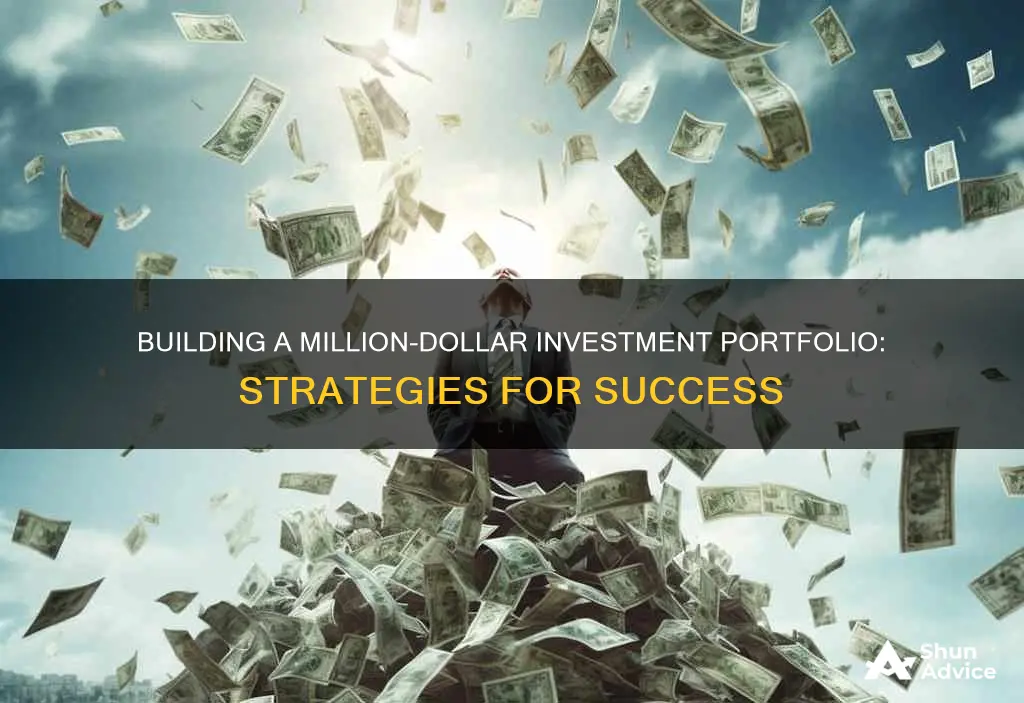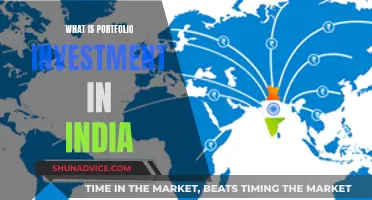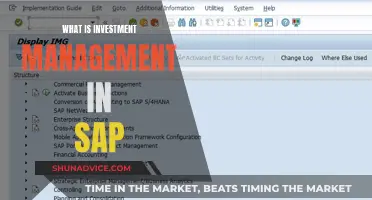
Building a million-dollar investment portfolio is a daunting task, but it is achievable with a well-thought-out plan, consistent savings, and smart investment strategies. Here are some key steps to help you get started on your journey towards the seven-figure club:
- Start early: Time is a crucial factor in wealth accumulation. The power of compounding means that even modest amounts invested regularly over time can lead to significant growth. The earlier you begin, the more time your money has to grow.
- Consistency is key: Make regular investments, even if the amounts are small. Automate your investments by setting up periodic transfers to your investment accounts. This strategy, known as dollar-cost averaging, helps reduce the impact of market volatility and takes advantage of market downturns.
- Pick the right accounts: Utilize retirement accounts such as 401(k)s and IRAs, which offer tax advantages that can boost your savings over time.
- Diversify your investments: Spread your investments across different asset classes, sectors, and company sizes. Consider exchange-traded funds (ETFs) and index funds, which provide instant diversification at low costs.
- Monitor and adjust your portfolio: While long-term investing is generally recommended, it's important to periodically review and rebalance your portfolio to ensure it aligns with your financial goals and risk tolerance.
- Seek financial advice: Consult a qualified financial advisor to get personalized guidance based on your specific goals and needs. They can help you navigate the complexities of investing and make tax-efficient choices.
| Characteristics | Values |
|---|---|
| Consistency | Regular investments, even modest amounts, compounded over time can lead to a million-dollar portfolio. |
| Time | The earlier you start, the more time your money has to grow. |
| Financial literacy | Manage debts, establish emergency funds, and utilize retirement accounts. |
| Dollar-cost averaging | Invest a fixed amount of money at regular intervals, reducing the impact of market volatility. |
| Diversification | Exchange-traded funds (ETFs) and index funds provide instant diversification. |
| Risk tolerance | Take more risk when young and decrease risk when older. |
What You'll Learn

Start early, stay invested
Starting early and staying invested is one of the most important principles when it comes to building a million-dollar investment portfolio. Here's why:
Time is Crucial
The earlier you start, the more time your money has to grow. Compound interest, or the interest calculated on the initial principal and the accumulated interest from previous periods, can significantly boost your wealth over time. The longer you invest, the more you benefit from compound interest. For example, assume that Sarah starts building her investment portfolio at age 25 with $5,000 and contributes $300 a month. Now, assume that Mike starts building his portfolio at age 40 with $10,000 and contributes $600 a month. If they both earn an 8% return on their portfolios, by the time they turn 65, Sarah will have about $1.04 million, while Mike will have around $594,847. By starting 15 years earlier, Sarah was able to accumulate almost double the amount that Mike did.
Consistency is Key
Regular investments, even modest amounts, compounded over time, can lead to a million-dollar portfolio. Consistency also makes it easier to build investing into your monthly budget and can help protect your portfolio against market volatility. A strategy called dollar-cost averaging involves investing a fixed amount of money at regular intervals, regardless of market conditions. This approach helps to reduce the impact of market volatility and takes advantage of market downturns by buying more shares when prices are lower. Over time, this strategy can lead to better returns and lower average purchase prices.
The Power of Starting Early
Starting early gives you a significant advantage in building wealth. The sooner you get started, the less you'll need to invest each month to see substantial earnings. For example, investing $350 per month for 35 years at a 10% average annual return would result in a portfolio value of around $1.1 million. On the other hand, if you wait 10 years to get started and then invest $700 per month for 25 years at the same average annual return, your portfolio value would be approximately $787,000. Even if you double your monthly contributions by waiting, you would still end up with around $312,000 less over time.
Saving Plans: The Benefits of a Conservative Financial Strategy
You may want to see also

Get rid of credit card debt
Building a million-dollar investment portfolio is a challenging but rewarding endeavour. Here are some detailed steps to help you get rid of credit card debt, which is an essential step towards achieving your financial goal:
Understand the Impact of Credit Card Debt
Before you can effectively tackle your credit card debt, it's crucial to understand its negative impact on your finances. Credit card debt often comes with high-interest rates, which can quickly compound and lead to even more significant financial burdens. The average credit card interest rate in the US is about 24%, which far outweighs the historical returns of the stock market, typically around 10%. This means that if you invest while paying credit card interest, you're likely losing money, even with decent investment returns. Therefore, addressing this high-interest debt should be a priority in your financial strategy.
Develop a Payment Strategy
The first step towards eliminating your credit card debt is to devise a concrete repayment plan. Here are some common approaches:
- Pay More Than the Minimums: Credit card issuers usually set a monthly minimum payment, often around 2% of the balance. However, banks make money from the interest charged each billing period, so paying only the minimum will extend the repayment period and result in you paying more in the long run.
- Debt Snowball Approach: This method focuses on using your sense of accomplishment as motivation. You prioritise paying off the smallest debt first and then roll that payment into the next smallest debt, gradually increasing your payments like a snowball rolling downhill.
- Debt Avalanche Method: Similar to the snowball approach, but instead of targeting the smallest balance, you focus on paying off the card with the highest interest rate first. This method can be faster and cheaper than the snowball method.
- Automate Your Payments: Setting up automatic payments ensures you don't miss any deadlines, avoiding late fees. This can be especially helpful if you struggle with forgetfulness or procrastination.
Consider Debt Consolidation
If you have good credit but feel overwhelmed by multiple debt payments, debt consolidation can help. This involves combining all your debts into a single account, so you only need to make one monthly payment. Here are some options:
- 0% Balance Transfer Credit Cards: Applying for a new credit card with a 0% introductory APR can help you transfer your existing credit card debt to this new account without accruing additional interest during the introductory period, usually 15 to 18 months.
- Personal Loans: Taking out a fixed-rate debt consolidation loan can be another option. Although you'll pay interest, personal loan interest rates are typically lower than credit card rates, helping you save money.
Work with Your Creditors
Don't hesitate to reach out to your creditors and explain your situation. They may be willing to negotiate payment terms or offer a hardship program, especially if you have a good track record of payments. A hardship program can provide relief by offering more affordable interest rates or waiving certain fees. It's worth exploring these options, as the worst they can say is no.
Seek Help Through Debt Relief Options
If your credit card debt has become unmanageable, it may be time to consider debt relief options such as bankruptcy or a debt management plan:
- Debt Management Plan: This involves working with a credit counselling agency to negotiate new terms with your creditors and consolidate your credit card debt. You'll make fixed payments to the counselling agency, but your credit accounts may be closed, and you may need to forgo new credit lines for a while.
- Bankruptcy: Filing for bankruptcy can provide a fresh start, but it will also impact your credit report for seven to ten years. Chapter 7 bankruptcy wipes out unsecured debt like credit cards, while Chapter 13 allows you to restructure debts into a payment plan over three to five years.
Lower Your Living Expenses
While working on eliminating your credit card debt, look for ways to reduce your living expenses. This can free up more money to put towards paying off your debt faster. Negotiate with service providers to get better deals, prioritise free or low-cost experiences, and set and stick to financial boundaries.
Remember, getting rid of credit card debt is a crucial step towards building wealth and achieving your financial goals. It takes discipline, consistency, and a well-thought-out plan, but it will put you on the path to financial freedom and set the foundation for your million-dollar investment portfolio.
Ally Invest: Portfolio Margin Trading Options Explored
You may want to see also

Diversify your investments
Diversification is a key principle of investing, and it can help manage risk in your portfolio. Exchange-traded funds (ETFs) and index funds are excellent options for beginners, as they provide instant diversification by spreading your money across multiple companies. These funds are also known for their low fees and passive management style.
ETFs and index funds are a great way to invest in the entire stock market or a specific index, such as the S&P 500. By investing in these funds, you can achieve broad diversification with a single investment. For example, an S&P 500 index fund will track the performance of the S&P 500 index, giving you exposure to 500 large companies across various sectors.
Another option for diversification is target-date funds. These funds automatically adjust your investments over time as you approach your target retirement date. They typically shift from riskier assets like stocks to safer options like bonds as you get closer to retirement. This helps to reduce risk and provide a more stable portfolio for the long term.
As you become more comfortable with investing, you can explore investing in individual stocks. Even when investing in individual stocks, diversification remains important. You can achieve this by selecting stocks from multiple sectors, such as technology, healthcare, and finance, or by choosing a mix of large-cap and small-cap stocks. Diversifying across sectors and company sizes can help reduce the impact of any single stock or industry on your portfolio.
Additionally, consider diversifying your investment accounts. Retirement accounts, such as 401(k)s and IRAs, offer tax advantages that can boost your savings. However, these accounts may have penalties for early withdrawals. Therefore, it's essential to diversify your investments across retirement and non-retirement accounts to balance tax advantages with accessibility.
By diversifying your investments, you can manage risk, reduce volatility, and increase your potential for long-term growth. It's a crucial strategy for building a robust and resilient million-dollar investment portfolio.
Labor-Saving Equipment: Worth the Investment for Automotive Division?
You may want to see also

Monitor and adjust your portfolio
Building a million-dollar investment portfolio is not a one-time endeavour. It requires regular monitoring and adjustments to stay aligned with your financial goals. Here are some detailed instructions on how to monitor and adjust your portfolio:
Monitor Your Portfolio Regularly:
Keep an eye on your portfolio's performance and the individual investments within it. Track how your investments are doing and be aware of any significant changes or trends. Monitoring your portfolio helps you identify areas that may need adjustments and ensures you stay informed about your investments.
Rebalance Your Portfolio:
Over time, the allocation of your portfolio among different investments will shift. For example, if you originally had a portfolio with 75% stocks and 25% bonds, market performance may change this allocation to 85% stocks and 15% bonds. To maintain your desired level of risk and growth, you need to rebalance by buying or selling assets to return to your original allocation.
Set a Schedule for Rebalancing:
Rebalancing should be done periodically, typically once or twice a year. Make it a regular part of your financial routine. For example, you can rebalance your portfolio every spring or at the end of the fiscal year. Consistency in rebalancing helps maintain the discipline needed for long-term success.
Consider Your Risk Tolerance and Goals:
When adjusting your portfolio, consider your risk tolerance and financial goals. If you are comfortable with higher risk, you may want to allocate more towards stocks or growth-oriented investments. If you prefer a more conservative approach, you might favour bonds or dividend-paying stocks. Ensure that your portfolio aligns with your short-term and long-term financial objectives.
Review and Adjust as Necessary:
While monitoring and rebalancing are essential, avoid making impulsive decisions. Evaluate your portfolio's performance and make adjustments as necessary, but do not react to every market fluctuation. Remember that investing is a long-term endeavour, and short-term market movements should not dictate your overall strategy.
By following these steps, you can effectively monitor and adjust your million-dollar investment portfolio. Regular monitoring and adjustments will help you stay on track and make progress towards your financial goals.
Where to Find National Savings and Investments
You may want to see also

Pick the right accounts
Picking the right accounts is a crucial step in building a million-dollar investment portfolio. There are two main types of retirement accounts to choose from: 401(k)s and IRAs.
A 401(k) is an employer-sponsored retirement account that allows you to contribute a portion of your pre-tax income, reducing your taxable income for the year. Many employers also offer a matching contribution, essentially giving you free money. However, annual contribution limits are higher for 401(k)s.
On the other hand, you can open an IRA (Individual Retirement Account) at a brokerage company, giving you more investment options than the funds available in a 401(k). IRAs also have tax benefits, as you don't pay taxes on dividends or capital gains within the account. You may also qualify for a tax deduction on your contributions with a traditional IRA, while withdrawals from a Roth IRA in retirement are usually tax-free. However, IRAs have lower annual contribution limits.
Both 401(k)s and IRAs offer tax-deferred growth, meaning you don't pay taxes on investment profits within the account. They also have a Roth option, which allows you to avoid taxes on withdrawals in retirement. These accounts are ideal for long-term goals like retirement but are not recommended for short-term goals due to tax penalties for early withdrawals.
If you've maxed out your contributions to retirement accounts or need access to your funds before retirement, consider a taxable brokerage account. For shorter-term goals, high-yield savings accounts or money market accounts are more suitable.
Investing: A Smarter Option Than Saving for Your Future
You may want to see also
Frequently asked questions
The earlier, the better. Starting early means you have more time for your money to grow, and you'll need to invest less each month to see substantial earnings.
This will depend on your specific investments, the returns you're earning, and your timeline. If you're earning a 10% average annual return, you'd need to invest $350 per month for 35 years, or $700 per month for 25 years.
Consistency is key. Regular investments, even modest amounts, compounded over time can lead to a million-dollar portfolio. Consider setting up automatic transfers to your investment accounts.
Dollar-cost averaging is an investment strategy where you invest a fixed amount of money at regular intervals, regardless of market conditions. This approach helps reduce the impact of market volatility and takes advantage of market downturns. Another option is to invest in an index fund, such as an S&P 500 index fund, which tracks the performance of multiple companies and requires less time for research.
It's important to have a solid financial plan and to pick the right accounts. Create a budget and track your expenses, build an emergency fund, pay off credit card debt, and learn about different investment concepts and terminology. Consider opening a retirement account, such as a 401(k) or an IRA, to take advantage of tax benefits.







